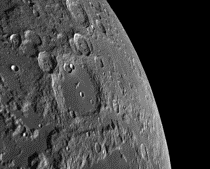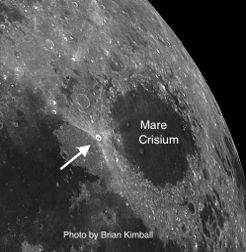 The week of February 10-16 takes us from Lunar Day 17 (one day after full moon) to Day 22. This week we will highlight the craters Cleomedes and Proclus, viewable on Monday evening.
The week of February 10-16 takes us from Lunar Day 17 (one day after full moon) to Day 22. This week we will highlight the craters Cleomedes and Proclus, viewable on Monday evening.
 Cleomedes: [NE/G15] Cleomedes is the first significant crater just north of Mare Crisium. It is a splendid crater, 80 miles in diameter, with terraced walls, rilles, and a small central mountain. There are also four craterlets and a Y-shaped rille on the northern half of the floor just east of the central mountain peak. Notice that the floor is unusually smooth. Because its southern rim touches one of the multi-rings encircling the Crisium basin, it is believed that lava rose up through Crisium fractures and smoothly covered the floor of Cleomedes. Under a low-angle Sun you might be able to detect that the rille cuts through a small dome on the northern section of the floor.
Cleomedes: [NE/G15] Cleomedes is the first significant crater just north of Mare Crisium. It is a splendid crater, 80 miles in diameter, with terraced walls, rilles, and a small central mountain. There are also four craterlets and a Y-shaped rille on the northern half of the floor just east of the central mountain peak. Notice that the floor is unusually smooth. Because its southern rim touches one of the multi-rings encircling the Crisium basin, it is believed that lava rose up through Crisium fractures and smoothly covered the floor of Cleomedes. Under a low-angle Sun you might be able to detect that the rille cuts through a small dome on the northern section of the floor.
 Proclus: [NE/H14] Proclus is a small crater located just west of Mare Crisium. In spite of its size, it is one of the brightest spots on the Moon. When you view it around the full Moon, you will notice it also has a system of rays that delicately fan out in a telltale butterfly-wing pattern, which tells you a lot about the flight path of the incoming projectile. Proclus is one of the best examples of what happens during a low-angle impact.
Proclus: [NE/H14] Proclus is a small crater located just west of Mare Crisium. In spite of its size, it is one of the brightest spots on the Moon. When you view it around the full Moon, you will notice it also has a system of rays that delicately fan out in a telltale butterfly-wing pattern, which tells you a lot about the flight path of the incoming projectile. Proclus is one of the best examples of what happens during a low-angle impact.
INTERESTING FACTS ABOUT SPACE FEBRUARY 10-15:
On Monday Mercury will be at its greatest elongation from the Sun and at magnitude -0.4. Try for it after sunset (binoculars may help). It is said that the great Copernicus himself never saw Mercury.
Galileo was born on Feb. 15, 1564
======================
It is highly recommended that you get a copy of Sky and Telescope’s Field Map of the Moon, the very finest Moon map available for use at the telescope. It is available for $10.95 at www.skyandtelescope.com and on Amazon. All features mentioned in this blog will be keyed to the grid on the Field Map and will look like this: Plato: [NW/D9]
Credits:
Courtesy of Gray Photography of Corpus Christi, Texas
Lunar photos: NASA / USGS / BMDO / LROC / ASU / DLR / LOLA / Moon Globe. Used by permission
- Rupes Cauchy: A Best Known Fault on the Moon - July 22, 2024
- Moon Crater Schickard – Crater Floor has Stripes - July 15, 2024
- Moon Craters Langrenus and Vandelinus - July 8, 2024